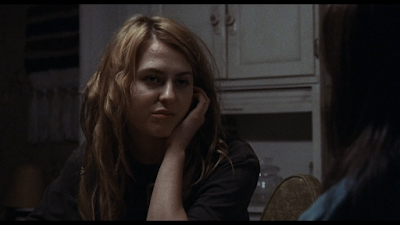Rob
Zombie’s remake of John Carpenter’s Halloween
in 2007 was a financial success prompting the studio to greenlight the
inevitable sequel. Enough time had passed after the making of that movie that
he had forgotten what a difficult experience it and was willing to go again but
this time he would no longer be constrained with having to remake another
person’s movie thus allowing him to follow his creative bliss, making a
follow-up that was more brutal and refreshingly stranger than the previous
movie. The result was Halloween II
(2009).
After a
brief flashback to Michael as a child, recounting a dream he had to his mother
(Sheri Moon Zombie), we are brought back to the present with a bloody and
battered Laurie Strode (Scout Taylor-Compton) walking down the middle of the
road in a shell-shocked daze after having just fought off and killed Michael
Myers (Tyler Mane). Sheriff Brackett (Brad Dourif) catches up to and tries to
calm her down. Slam cut to a close-up of her screaming face as she’s wheeled
along a hospital corridor on a gurney.
Back at
the site of the climactic showdown, an unconscious Dr. Sam Loomis (Malcolm
McDowell) is also sent off in an ambulance while Michael’s body is carried away
as well but when the two inept coroners driving the truck crash into a cow
(?!), Michael rises and disappears into the night. At the same moment, Laurie
rises from her hospital bed to see her friend Annie (Danielle Harris), another
survivor from the encounter with Michael, and Zombie makes a point of lingering
on these two young women, their bodies damaged by what happened to them, but
those wounds will eventually heal. It is the psychological damage that Zombie
is interested in exploring with this movie.
Laurie
takes pills for pain, anxiety, you name it, still traumatized and living with
Brackett and his daughter Annie. It’s a well-played scene as we see these
people trying to get on with their lives as best they can considering what
they’ve been through. Laurie, especially, is lost in the world. Her parents are
dead and Michael’s body was never found, which leaves her frustratingly without
closure.
Meanwhile,
Loomis has bounced back as a flashy television personality, cashing in on what
happened a year ago and Zombie re-introduces his character via a super slick
tracking show that would make Michael Mann proud, combined with a very Aaron
Sorkin-esque walk-and-talk sequence. He’s become a petulant primadonna, which
Malcolm McDowell has fun playing to the hilt. The “good” doctor happily cashes
in on the fascination with Michael Myers but when someone brings up the
possibility of the killer still being alive he loses it and we see the cracks
in the façade. He is not above doing an interview in front of the now-abandoned
Strode house as he tells his long-suffering assistant, “Bad taste is the petrol
that drives the American Dream.”
The movie
has the requisite kills that fans have come to expect from the franchise but
here it feels as if Zombie is getting them out of the way as he’s more
interested in tracking the shattered lives of the main characters than goosing
the body count for cheap thrills. We get considerate character beats, such as
Sheriff Brackett extolling the virtues of Lee Marvin in Cat Ballou (1965) to Laurie and his daughter who have no idea what
he’s talking about. They provide brief moments of levity in an otherwise
extremely grim movie.
A child
of the 1970s, Zombie populates his movie with a bevy of character actors who
were stars during that time and so we have Dr. Johnny Fever himself, Howard
Hessman as the owner of a cool independent record store that Laurie works in
and Margot Kidder as Laurie’s therapist. Despite working for a studio, Zombie
still manages to find room for his troupe of favorite actors, such as Richard
Brake, Jeff Daniel Phillips and Daniel Roebuck, many of whom get the honor of
being brutally dispatched by Michael.
This
being a Rob Zombie movie and his perchance for all things white trash, he
trades in the suburbs of Haddonfield, that we normally associate with the
Halloween franchise, for his preferred locales – indie record stores, deserted
barns and sleazy strip clubs. He employs a desaturated color palette for this
grim movie, saving key moments for splashes of color, such as the
aforementioned strip club and the Halloween party Laurie attends – both awash
in garish reds.
With
Loomis’ endless press interviews and book signing gigs, Zombie is showing how
infamous crime cases are commodified and exploited by people like Loomis
without caring about the damage that has been done and continues with this
careless exploitation. It brings out kooky fans and grief-stricken parents of
kids killed by Michael that want to vent their anguish and anger on the doctor
who has nothing but contempt and indifference for his audience. Laurie
continues to unravel, permanently scarred both physically and psychologically
by Michael and Loomis’ book only reopens these old wounds.
With both
of his Halloween movies, Zombie is
not interested in making a gimmicky Scream
meta slasher movie or an over-the-top kill-happy Friday the 13th movie but instead grounding the
franchise mythos in something approximating realism by showing the toll
Michael’s bloody rampage takes on Laurie and those close to her. It’s not funny
but sad, leaving one drained by the end of the movie, much like Laurie.
Characters live with trauma and try to carry on with their lives but Michael
won’t let them. People are killed in horrible, painful ways and those that
survive are haunted, their lives shattered beyond repair.




